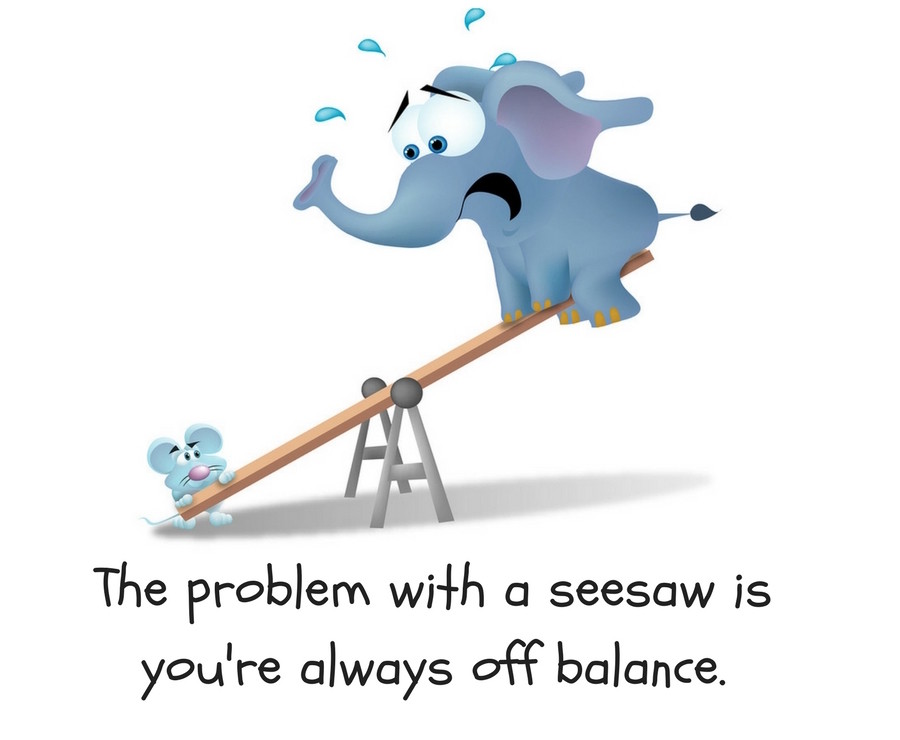 When the moon grows, it waxes. When it declines, it wanes.
When the moon grows, it waxes. When it declines, it wanes.
Waxing is a good thing. We use it in expressions like, “He waxed eloquently“ or “She waxed lyrical.”
But what about someone who “waxes on and on” – not so good.
Waxing is a good thing IF it doesn’t go on too long. At some point, the very thing that contributed to your success can trigger your decline. It’s like tipping on a seesaw – what was once the upside becomes the downside.
When the seesaw tips, our tendency is to try to rebalance. And often (but not always) that is the best thing to do.
The rhythm of the moon is to wax and wane in a natural flow of rebalancing. We breathe in and out. Without this natural rebalancing, we could not exist.
But there are other seesaws in our lives where rebalancing is not the best solution.
Consider the hard work/ vacation seesaw – where you work harder and harder until you start to burn out. So you take a vacation and get reenergized. With renewed energy, you jump back into the fray until you burn out again. That’s a tough way to live.
 Or consider the over-/ under-management seesaw where a leader delegates responsibility but swoops back in periodically giving direction, and then disappears again – a confusing and demoralizing seesaw for their team, and ineffective management style.
Or consider the over-/ under-management seesaw where a leader delegates responsibility but swoops back in periodically giving direction, and then disappears again – a confusing and demoralizing seesaw for their team, and ineffective management style.
The problem with being on a seesaw is you’re always off balance. And you can throw other people off balance.
One way to deal with a seesaw is to try to modulate yourself so you stay more in the middle. With the hard work/ vacation seesaw, you can try to not wait until you burn out before you take time off.
But there’s another very different solution. You don’t have to do the opposite of what you were doing to rebalance. You don’t have to go back and forth between the two ends of a seesaw.
You can simply get off the seesaw.
One way to get off the hard work/ vacation seesaw is to do work you enjoy so much it feels like play much of the time.
In the case of the over-/ under-management seesaw, you can get off the seesaw by redefining your role as a manager. Instead of seeing your role as an overseer, you see it as a servant. Your job is to help them develop the skills they need, ensure access to the resources they need, provide the information they need, and to be available when they need your help or advice.
3 Steps to Wax Off the Seesaw
Step One: Recognize you’re on a seesaw.
It’s not so easy to get off a seesaw because we often don’t even recognize we’re on one. And when we do, we assume it’s the way of life and there are no other options. So the first step is to simply recognize your situation – that you are on a seesaw that is not serving you.
Step Two: Simply stop what you are doing; take NO other action.
When off balance, our natural inclination is to do the opposite of what you were doing. But this reaction, as logical as it seems, keeps you on the seesaw. It can feel uncomfortable to simply stop what you are doing without taking any other action. This tension is natural and important. It’s called creative tension because it is the creative force that will help you move to a new possibility.
Step Three: See a bigger picture.
Take time for reflection. Look for a bigger picture that includes more than the seesaw. Ask yourself questions like:
- How exactly does this seesaw work? What do I do at each end? What prompts me to move toward the other end?
- How does this seesaw affect my ability to do my work?
- How does it affect me personally?
- How does it affect others?
- What role does this seesaw play?
- What benefits do I get from this seesaw?
- Is there a bigger purpose that this seesaw serves?
- Is it possible to accomplish both ends of the seesaw at the same time?
- Is there something that is more important than either end of the seesaw?
- What might it look like if I weren’t on this seesaw?













I agree with your points, especially ‘get off the seesaw…see your role as a server.’ Leaders should realize that they do not have to participate and entertain certain mindsets such as the seesaw. “Get off the seesaw”- powerful statement. Also, seeing your leadership role as a serving role highlights and emphasizes an undertone that pivots and shifts perspective. Great read!
It IS a matter of perspective. Sometimes all you can see is the seesaw and your only choice is to go back and forth. The best way off is to redefine your relationship to the issue the seesaw is supposedly addressing. Thanks for deepening the conversation Gabrielle.
Hi Jesse Lyn,
I remember the exact day I decided to get off the see saw. It was the beginning of a whole new professional and personal life.
Great post!
Kate
It’s almost always a new beginning because you can’t fully anticipate what you’ll find until you actually get off the seesaw. Thanks for sharing your experience, Kate.
One Exacerbator is “work really hard, take a vacation, return to a huge pile of work and wind up behind the curve.” Sometimes makes the vacation stressful, and maybe a good time to consider dismounting altogether.
And dismantling the seesaw! 🙂
Love your metaphor! One reality is that some roles do have natural peaks. Example: my brother-in-law was a director in Hollywood. When they were shooting a series, it was intense, nonstop days and nights. And then, it would be over.He would take a huge break then until the next round. The trick, I believe, is to see if there is a pattern in one’s work and to adjust accordingly for it. AND– if the seesaw ride is no longer rewarding and fun- yep: DISMOUNT
True. We need to learn which are the seesaws that work for us, and to make sure they are working well, and to identify which are the seesaws we need to get off. Not always easy to discern.
Thomas A. Edison was known to work intensely for long periods of time, and yet he is quoted as saying, “I never worked a day in my life — it was all fun.” If true, he waxed a hellofa lot.
Great quote! Sounds like he wasn’t on the seesaw.
I love the see saw analogy Jesse. It provides a whole new perspective and makes so much sense.
So glad you found it helpful, Jenny!